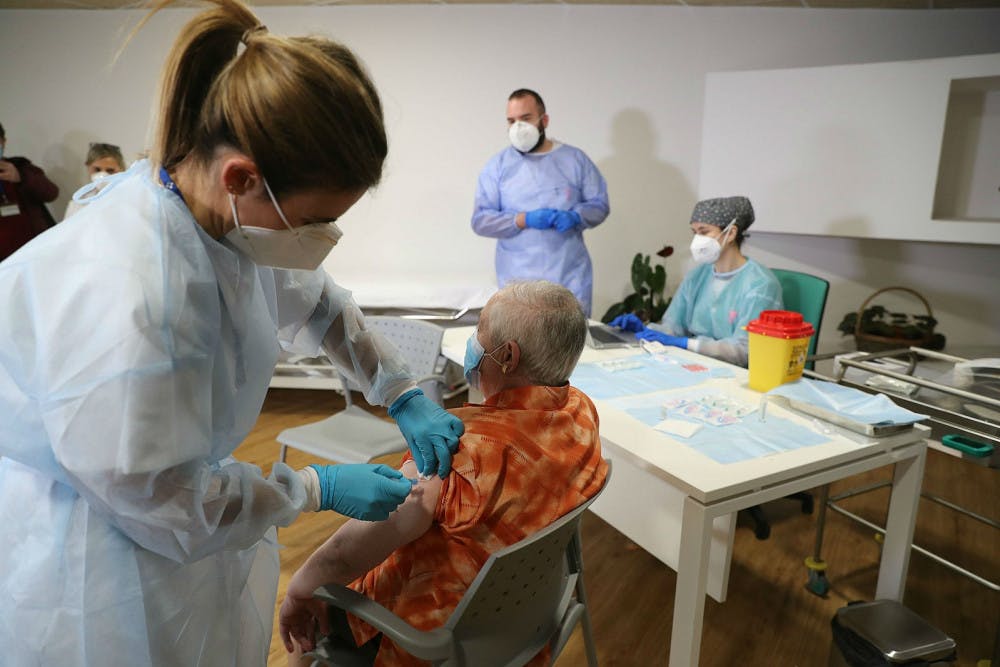In December, more than 40 interest groups and businesses — representing groups ranging from school bus drivers to librarians — wrote letters to the Rhode Island Department of Health regarding COVID-19 vaccine distribution, with many laying out reasons why they should be prioritized in the next phase, according to the Providence Journal.
After much anticipation, RIDOH announced the next phase of its vaccination schedule Jan. 28. Notably absent from the new prioritization plan was occupation.
“The framework we are using is based on three criteria: age, high risk conditions and geography,” Director of RIDOH Dr. Nicole Alexander-Scott said during the COVID-19 briefing when she unveiled the plan. Health experts say the plan will focus on reducing severe cases of COVID-19 in the state rather than curbing spread by prioritizing citizens for whom the disease is more likely to be fatal.
Healthcare workers, first responders and other high risk groups such as prisoners and firefighters have been receiving the vaccine in phase one of the state’s distribution plan, which started in December according to RIDOH.
Starting Jan. 30, in phase two of the plan, Rhode Island also began expanding vaccine eligibility to those 75 and older in select counties as the state shifted to primarily age-based vaccine prioritization.
“The aims of this next phase are to protect those most at risk of hospitalizations and death from COVID-19,” Alexander-Scott said. People over the age of 60 comprise almost two-thirds of hospitalizations and 94 percent of fatalities in Rhode Island, she said. This new approach is “much less complicated and it means the vaccine will get administered much more quickly,” Alexander-Scott added.
Vaccinations will also be accelerated in communities that have seen disproportionately high hospitalizations and deaths, such as Providence and Central Falls. “Getting people vaccinated in harder hit communities is the right thing to do,” Alexander-Scott said.
Associate Professor of Medicine and Behavioral and Social Sciences Philip Chan, who serves as a consultant medical director for RIDOH, told The Herald that “if we can control some of these hotspots, it's going to be good for the entire state.”
To date, the federal government has not implemented one unified vaccine rollout strategy. And the debate between vaccinating those most vulnerable to serious illness from COVID-19 and those most exposed to the virus has created drastically different rollout strategies across state lines.
Chan said this gives Rhode Island greater flexibility, but believes the lack of coordination and guidance can be “frustrating.” RIDOH created a COVID-19 Vaccination Subcommittee composed of physicians, scientists and community leaders to design the distribution plan, he said.
“If your goal is to reduce the rate of infection, you would prioritize essential workers,” said former FDA Commissioner Scott Gottlieb in an interview on Face the Nation. “If your goal is to maximize the preservation of human life with a vaccine ... then you would bias the vaccine towards older Americans.”
Rhode Island went with the latter, but some essential workers are skeptical.
Maya Chavez, a civics teacher at Dr. Jorge Alvarez High School in Providence, said that “this sudden shift to an age-based model is deeply concerning. People are getting COVID at work. We have school bus drivers who are driving four buses of kids each day … And they're supposed to wait in line behind people who work from home.”
Chavez isn’t as worried about getting the virus as she is about spreading it. “I'm 33. Chances are, if I were to get COVID, I'd probably be fine,” she said. “But there's the risk that if I come into school that I transmit that to a student. I've got kids who live with high risk family members.”
In contrast to Rhode Island, almost half of all states and Washington D.C. are already allowing all teachers to be vaccinated, according to the New York Times. The CDC classifies those who work in the educational sector as “frontline essential workers,” and recommends that they be vaccinated alongside those over the age of 75, according to its website.
While the Ocean State will not be prioritizing vaccines for teachers, Alexander-Scott said that 58 percent of teachers and teaching staff will be vaccinated “early on” because of their age, health conditions or location. Rhode Island’s approach “captures many members of our various critical infrastructure occupations,” she said.
But Chavez said that highlighting teachers is a “narrow” view of the kinds of people that work in schools. “What about the ages of our custodians, our cafeteria workers, our TAs and our clerks — everybody else who is physically present in the school buildings?” she asked.
Still, Chan believes that ventilation, social distancing and masks have been “working gracefully” in preventing spread of the virus in controlled work settings such as schools. Additionally, University economist Emily Oster, who started a COVID-19 school infection dashboard that collects data on about ten million students and one million staff, argued in a Nov. 20 op-ed in the Washington Post that “schools are not spreading COVID-19.”
State Director for AARP Rhode Island Kathleen Connell wrote in a statement to The Herald that the organization “welcome(s) the shift in the state’s vaccination plan.” In an interview with The Herald, she said the AARP has received numerous messages regarding confusion about the vaccination process and said a larger concern is ensuring that those who are eligible know how and when to register for COVID-19 immunization.
RIDOH estimates that young people between the ages of 16 and 39 — including college students — will not be vaccinated until June and July. This estimated timeline, released alongside Rhode Island’s rollout plan, aligns with President Paxson P’19’s prediction that the University will begin vaccine distribution this summer, beginning with first-years..
Still, Chan believes that if additional vaccine candidates such as the Johnson & Johnson vaccine are granted emergency use authorization as expected, then the distribution timeline will likely be shortened.
“I do think it may be reasonable for Brown students to anticipate being vaccinated by summer,” Chan said, “if not a little bit before.”
Correction: A previous version of this article incorrectly referred to AARP Rhode Island as the RI American Association of Retired Persons. The Herald regrets the error.

ADVERTISEMENT




